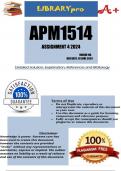Exam (elaborations)
APM1514 Assignment 4 2024 - DUE 10 June 2024
- Institution
- University Of South Africa
APM1514 Assignment 4 2024 - DUE 10 June 2024 ;100 % TRUSTED workings, explanations and solutions. For assistance call or W.h.a.t.s.a.p.p us on ...(.+.2.5.4.7.7.9.5.4.0.1.3.2)........... Question 1: 8 Marks Suppose that the population of South Africa was approximately 60, 04 million at the begin...
[Show more]



